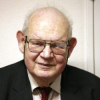Benoit Mandelbrot

Benoit Mandelbrot
Benoit B. Mandelbrot was a Polish-born, French and American mathematician with broad interests in the practical sciences, especially regarding what he labeled as "the art of roughness" of physical phenomena and "the uncontrolled element in life." He referred to himself as a "fractalist". He is recognized for his contribution to the field of fractal geometry, which included coining the word "fractal'", as well as developing a theory of "roughness and self-similarity" in nature...
NationalityFrench
ProfessionMathematician
Date of Birth20 November 1924
CountryFrance
Pictures were completely eliminated from mathematics; in particular when I was young this happened in a very strong fashion.
Everybody in mathematics had given up for 100 years or 200 years the idea that you could from pictures, from looking at pictures, find new ideas. That was the case long ago in the Middle Ages, in the Renaissance, in later periods, but then mathematicians had become very abstract.
I went to the computer and tried to experiment. I introduced a very high level of experiment in very pure mathematics.
If you look at coastlines, if you look at that them from far away, from an airplane, well, you don't see details, you see a certain complication. When you come closer, the complication becomes more local, but again continues. And come closer and closer and closer, the coastline becomes longer and longer and longer because it has more detail entering in.
Self-similarity is a dull subject because you are used to very familiar shapes. But that is not the case. Now many shapes which are self-similar again, the same seen from close by and far away, and which are far from being straight or plane or solid.
The straight line has a property of self-similarity. Each piece of the straight line is the same as the whole line when used to a big or small extent.
If you look at a shape like a straight line, what's remarkable is that if you look at a straight line from close by, from far away, it is the same; it is a straight line.
There are very complex shapes which would be the same from close by and far away.
Some mathematicians didn't even perceive of the possibility of a picture being helpful. To the contrary, I went into an orgy of looking at pictures by the hundreds; the machines became a little bit better.
I was in an industrial laboratory because academia found me unsuitable
I was asking questions which nobody else had asked before, because nobody else had actually looked at certain structures. Therefore, as I will tell, the advent of the computer, not as a computer but as a drawing machine, was for me a major event in my life. That's why I was motivated to participate in the birth of computer graphics, because for me computer graphics was a way of extending my hand, extending it and being able to draw things which my hand by itself, and the hands of nobody else before, would not have been able to represent.
For much of my life there was no place where the things I wanted to investigate were of interest to anyone.
If you assume continuity, you can open the well-stocked mathematical toolkit of continuous functions and differential equations, the saws and hammers of engineering and physics for the past two centuries (and the foreseeable future).
A fractal is a mathematical set or concrete object that is irregular or fragmented at all scales.